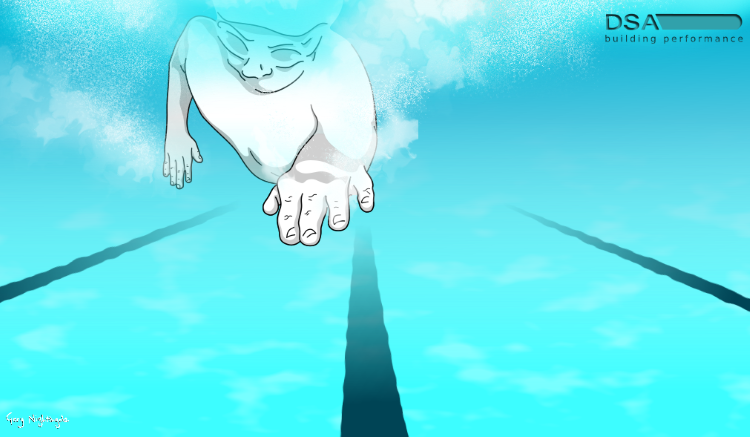
How to get up the career ladder at work with minimal turbulence but first to the pool
Right hand enters the water, like through a letterbox, just in front of the ear. Then drives forward till straight, relaxed shoulder opens, providing length and rotation.
Right, elbow breaks outwards, and lower arm moves into early vertical forearm with high elbow and holds a Swiss ball volume of water with no bubbles – this is the catch.
Left arm is recovering through the air and hand enters the water while hips and shoulders drive forward in unison, moving over the top of the water held in catch by right arm. Core is “plank” tight, connecting the top half; arms, shoulders, upper back to the bottom half; hips, glutes and legs.
In the drive phase, ankles are fully open and toes pointed creating maximum length between leading fingers and toes. Feet flutter kick to assist hip rotation. The kick starts from the glutes; legs lift and descend rhythmically at exactly the same time. Pressure is applied by the arm, shoulder and back muscles from the catch right through the drive and the stroke cycle repeats continuously.
The stroke appears to start with hand entry, though it is preceded by hip rotation. Everything starts from the hip.
And then the difficult part, breathing! Seamlessly integrating inhale and exhale from the diaphragm while remaining balanced and stable in the infinitely unstable body of water. Relaxed neutral neck and still submerged head are key here.
What about pace? Swim too slow and you sink, too fast and you tire exponentially.
The coach notices and reflects back, raising awareness and enabling improvement
How do you think about all that at once? You can’t. You can only really focus on one small element at a time and overtime, it all becomes learnt behaviour, tacit knowledge – or that is the hope.
Multiply complexity – swim in the sea. Wind, waves, currents, bitter cold, salt, jelly fish and rock outcrops all conspire to distract your attention from technique and direction – there are no black lines on the bottom of the sea.
And you can’t see any of this, you have to feel it. This is where the coach is needed. She sees what’s happening and reflects back to you so you are aware, then you can make adjustments and practise. Awareness, what is, is uppermost for improvement in any endeavour. You become consciously incompetent – “I can’t breathe” or “I can’t hold my core in plank” – though over time, many years, you become unconsciously competent and gracefully move forward at pace, fully connected and as one with the water, no splash, no noise nor bubbles.
New manager and avoiding sinking
I did my first triathlon swimming breaststroke – not good in the North Sea, nor fast. I exited the water with the other stragglers and drank tea for five minutes to warm up before jumping on my bike. After the event I decided to do another but this time I was going to learn front crawl.
For most of my racing years my self-taught front crawl involved swinging my arms and kicking my legs as fast as I could to avoid sinking – there wasn’t much coordination between all my many moving parts.
The swimming trainer would shout “Dave, feel the water” from poolside. I remember thinking “what is he even talking about?” as I frantically propelled forwards in the turbulence my effort caused.
At this time I was entering management level at work where I also frantically propelled forwards in the turbulence my effort caused. I was an equally unaware new manager and swimmer; though I did know I wasn’t very good at either. It was all happening all at once – too many uncoordinated swimming movements and far too much to cope with as an ill prepared manager. It was all I could do to avoid sinking in both.
As a manager I was fortunate to have my first coach in my mid-thirties. As a swimmer I endured well into my late forties before I stopped, unlearned my self-taught technique, hired a coach, and started again from scratch. And here I am, 15 years on still learning to swim, though with better technique, faster than I have ever been.
Cutting through the noise and developing good technique
I’ve studied the ins and outs of swimming technique, YouTube is great for that, and applied micro improvements along the way. My various swimming coaches over the years have all been consistent in their encouragement to focus on one thing at a time. And as those ‘one things’ have become ingrained, my overall technique has improved. It’s a long, patient path to mastery: there are no quick fixes, no silver bullets – in the pool or at work. I’m on the lower slopes of the path to mastery though now at least I can “feel the water”.
It feels good to have slowed it all down and identified the essentials of swimming, for me at least.
If you would like to cut through the noise of ‘management’ and develop good technique then sign up for my Coach for Results course, where you will learn the essentials of a coaching style of management – ten easy lessons to empower your people to achieve the extraordinary and in the process propel yourself up the ranks with minimal turbulence.
Leadership Team Coach Dave Stitt works with construction industry executives and project teams enabling them to deliver remarkable results in a remarkable way.
Dave is the creator of Coach for Results, an accessible online course teaching the basics of a coaching management style so managers can grow confidence, capability and enthusiasm in the people around them.
Read more blogs from Dave: ‘Coaching management style relieves pressure on younger managers’.
Other blogs you might like:
Why would you use a leadership coach?
Which choice will you make to develop your leadership impact?

+ 3 more
48 years experience in construction industry, last 24 as leadership team coach